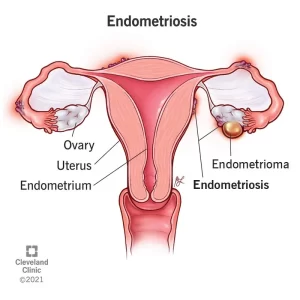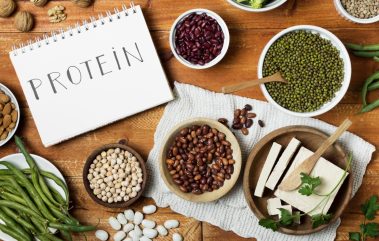Endometriosis refers to the condition when tissue similar to the endometrial tissue (inner lining) of the uterus grows outside of the uterus. (World Health Organization, 2023) In most cases, this tissue growth usually happens around the organs involved in reproduction, like the fallopian tubes, ovaries, and uterus, as well as the lining of the pelvic area. It can sometimes grow in other places like the bladder, rectum, intestines, and stomach, but this is not as common.

Source: Cleveland Clinic– In endometriosis, endometrial-like tissue grows outside the uterus.
Estrogen is a hormone that tells the uterus to grow more endometrial tissue each month, and it can also make endometriosis grow more. When there is too much estrogen, it can cause the endometriosis tissue to become inflamed and irritated, leading to pain. As the endometriosis grows and gets irritated over time, it can create scar tissue, which can cause even more pain. This scarring can also lead to other problems, like infertility or bowel issues, depending on where the endometriosis is growing.
What are the signs and symptoms of Endometriosis?
- Pelvic pain: This is the most common symptom of endometriosis. Women may experience sharp, cramping pain ranging from mild to severe. This discomfort may occur during menstruation, ovulation, sexual intercourse, bowel movements, or urination.
- Heavy or irregular menstrual periods: Prolonged menstruation, irregularities in the menstrual cycle, and sometimes spotting between periods are seen.
- Chronic pelvic pain: Endometriosis can lead to persistent pelvic and lower back pain ranging from dull aches to sharp pains, which may not be connected to menstrual cycles.
- Bowel or urinary symptoms: Pain or discomfort during bowel movements or urination may be experienced. It may also cause diarrhea, constipation, bloating, or blood in the stool or urine.
- Fatigue and low energy: Endometriosis causes exhaustion, low energy levels, and severe fatigue due to the continuous inflammation and pain related to it. These symptoms can greatly impact one’s quality of life.
- Other symptoms: It can also cause nausea, vomiting, headaches, and pain in other areas of the body (legs or lower back).
- Painful sexual intercourse: When a person experiences painful intercourse, it can be a sign of endometriosis. This type of discomfort can range from superficial to deep and may occur during or following sexual activity.
- Infertility or difficulty getting pregnant: Endometriosis may make it difficult to conceive by causing inflammation, scarring, and adhesions in the pelvic organs.

Source: Endometriosis: Etiology, pathobiology, and therapeutic prospects (Saunders, P. T. K., & Horne, A. W., 2021)
Not all women with endometriosis show all of the symptoms. The intensity of the symptoms also varies.
Diagnosis
Until today, a standard protocol for the diagnosis of endometriosis has not been established. Currently, doctors rule out other possible diseases before arriving at the diagnosis of endometriosis. Some of the steps and tests that help in the diagnosis include:
- Obtaining a Medical History and performing a Physical examination.
- Pelvic and transvaginal ultrasound is used to identify any abnormal growth.
- MRI (Magnetic Resonance Imaging) provides an image of deeper tissues.
- Laparoscopy is a minimally invasive surgical procedure that involves inserting a thin, lighted tube with a camera through a small incision in the abdomen. This allows the healthcare provider to directly visualize and biopsy any abnormal tissue. (Saunders, P. T. K., & Horne, A. W., 2021)
Treatment Options
There is no definitive cure for endometriosis yet. The current approach has been to manage the symptoms to improve the quality of life for women. (Saunders, P. T. K., & Horne, A. W., 2021)
- Hormone Suppressive Therapy– In order to suppress the activity of the ovaries, contraceptive pills and other hormone therapies are used.
- Pain-killers and Neuromodulators– Analgesics like Non-steroidal anti-inflammatory drugs (NSAIDs) and neuromodulators are used by women to manage pain.
- Surgical Removal of lesions– In extreme cases, the endometrial lesions are surgically removed to help improve quality of life. But it has been seen that women come back again with symptoms within 5 years of surgery.
Unfortunately, due to a lack of standard protocol for diagnosis and treatment, the journey through endometriosis is very long and painful and can take a toll on the mental health of women.
Challenges Faced by Female Athletes with Endometriosis
A study conducted by Kristie Klingenberg et. al. to understand the impact of endometriosis on female athletes brought out the following key points:
- Performance: Endometriosis-related pain and fatigue can impact an athlete’s ability to perform at their best. Menstrual irregularities can also disrupt training and competition schedules.
- Mental health: Living with chronic pain can take a toll on an athlete’s mental health, leaving the athlete feeling anxious, alone, and depressed.
- Training: Pelvic pain and discomfort can make it difficult for female athletes with endometriosis to train effectively. They may also need to modify their training schedules to accommodate their symptoms.
- Recovery: Endometriosis-related pain and fatigue can affect an athlete’s ability to recover from training and competitions, needing longer recovery times.
- Sleep: Chronic pain and discomfort affect good quality sleep, which is essential for recovery and performance.
- Psychological barriers: The impact of endometriosis on an athlete’s physical and mental health can create psychological barriers that may prevent them from achieving their athletic goals.
- Increased Injury Risk: Studies suggest that there is an increased risk of musculoskeletal injury with endometriosis. Chronic inflammation also increases the time to recover from injuries.
Case Study and Video
Story of a female athlete with endometriosis
A 20-year-old intercollegiate volleyball athlete got hurt during practice and had pain in her lower belly and trouble urinating. She went to the hospital, but the tests didn’t show anything. A catheter was inserted to help her relieve her bladder. The gynaecologist suspected endometriosis after scanning. Later laparoscopy confirmed endometriosis. She had surgery, and the doctor said she could do light exercise after a week. But when she got hit by a volleyball again, she got the same pain as before. Unfortunately, she had to stop playing volleyball for the rest of the season, and she decided not to play anymore as the gynaecologist informed her that her participation in contact sports would increase further incidences of Pain. (Piccininni, J. J., Jones, M., Andrews, A. K., & Ellis, J., 2007)
Additionally, here are links to the videos of Women sharing their struggles and journey with endometriosis
- Brut America on the Experience of Women “Living with Endometriosis”
- Playlist by Jean Hailes in the series Endo-wise
Dietary Strategies for Endometriosis
- Mediterranean diet– This diet emphasizes having fruits, vegetables, whole grains, legumes, nuts, seeds, and olive oil while limiting the intake of red meat and processed foods. This has been seen to help women with endometriosis.
- A low FODMAP diet: Some women with endometriosis may experience gastrointestinal symptoms, such as bloating, gas, or diarrhea. A low FODMAP diet may help to alleviate these symptoms by reducing the intake of fermentable carbohydrates like beans, legumes, rye, onion, garlic, and dairy products.
- Increase intake of fruits and vegetables: A diet rich in fruits and vegetables has been associated with a decreased risk of endometriosis and fewer symptoms. Consume at least 5 servings of fruits and vegetables per day.
- Limit consumption of red meat: A high intake of red meat has been associated with an increased risk of endometriosis as they affect estrogen levels. Chicken, Eggs, Fish, and plant-based proteins can be consumed instead.
- Increase consumption of omega-3 fatty acids: Omega-3 fatty acids have anti-inflammatory properties and may help to reduce inflammation associated with endometriosis.
- Avoid trans fats: Trans fats have been associated with increased inflammation and may exacerbate symptoms of endometriosis. It is advisable to avoid foods that contain trans fats, such as fried foods, baked goods, and processed snacks.
- Increase fibre intake: A high-fibre diet may help to reduce estrogen levels, which can help to alleviate symptoms of endometriosis. Consuming at least 25 grams of fiber per day from whole grains, fruits, and vegetables is recommended.
- Limit caffeine and alcohol intake: Caffeine and alcohol have been associated with increased estrogen levels, which can worsen the symptoms of endometriosis. It is therefore recommended to limit the intake of caffeine and alcohol.
- Limit Foods Rich in Phytoestrogens: Limiting phytoestrogens can prevent an increased estrogen level that can worsen the symptoms of endometriosis. Sources include soybean and its products, sesame seeds, barley, alfalfa, wheat germ, and rice bran.
It is important for female athletes with endometriosis to understand that they are not alone in this journey. This condition can take a toll on the physical and mental health of the athlete and can lead to a decrease in performance. Although performance is a key parameter for an athlete, it is rather important to prioritize the athlete’s health and provide reassurance. Seeking support from family members, coaches, sports nutritionists, and psychologists and joining support groups can help in managing stress-related disorders that come along with the condition. Always remember to be kind and empathetic.
References:
- World Health Organization. (2023, March 24). Endometriosis. World Health Organization (WHO). Retrieved April 18, 2023, from https://www.who.int/news-room/fact-sheets/detail/endometriosis
- Saunders, P. T. K., & Horne, A. W. (2021). Endometriosis: Etiology, pathobiology, and therapeutic prospects. Cell, 184(11), 2807–2824. https://doi.org/10.1016/j.cell.2021.04.041
- Puranda, J. L., Silva, D. F. D., Edwards, C. M., Nagpal, T. S., Souza, S. S., Semeniuk, K., & Adamo, K. B. (2023). Association Between Reproductive Health Factors and Musculoskeletal Injuries in Female Canadian Armed https://doi.org/10.1089/jwh.2021.0647
- Piccininni, J. J., Jones, M., Andrews, A. K., & Ellis, J. (2007). Endometriosis in a division-II collegiate volleyball athlete: A case study. Athletic Therapy Today: The Journal for Sports Health Care Professionals, 12(5), 11–13. https://doi.org/10.1123/att.12.5.11
- Nirgianakis, K., Egger, K., Kalaitzopoulos, D. R., Lanz, S., Bally, L., & Mueller, M. D. (2022). Effectiveness of dietary interventions in the treatment of endometriosis: A systematic review. Reproductive Sciences (Thousand Oaks, Calif.), 29(1), 26–42. https://doi.org/10.1007/s43032-020-00418-w




